|
 |
|
 |
|
 |
 |
| |
16:9 in English: Towards an Aesthetic of Slow in Contemporary Cinema
By MATTHEW FLANAGAN
Although established forms of narration across national cinemas are always in a state of transition, a particularly striking dichotomy between mainstream continuity style and marginal art cinema has become increasingly apparent in recent years. The disparity has primarily emerged in the relationship between speed and editing, and now calls for a closer examination of the binary extremes of ‘fast’ and ‘slow’.
In defiant opposition to the quickening of pace in mainstream American cinema, a distinctive narrative form devoted to stillness and contemplation has emerged in the work of a growing number of filmmakers over the last two decades. Most widely exhibited on the festival circuit, this “cinema of slowness” (as categorised by Michel Ciment in 2003) has begun to signify a unique type of reflective art where form and temporality are never less than emphatically present, and a diminution of pace serves to displace the dominant momentum of narrative causality. The most distinctive active practitioners of such a style might be thought to comprise, in loose chronological order, Philippe Garrel, Chantal Akerman, Theo Angelopoulos, Abbas Kiarostami, Béla Tarr, Aleksandr Sokurov, Hou Hsiao-hsien, Tsai Ming-liang, Sharunas Bartas, Pedro Costa, Jia Zhang-ke, Apichatpong Weerasethakul, Lisandro Alonso, Carlos Reygadas, Gus Van Sant and Albert Serra.
The formal characteristics shared by these filmmakers are immediately identifiable, if not quite fully inclusive: the employment of (often extremely) long takes, de-centred and understated modes of storytelling, and a pronounced emphasis on quietude and the everyday. In light of the current prevalence of these stylistic tropes, it is perhaps time to consider their reciprocal employment as pertaining not to an abstract notion of “slowness” but a unique formal and structural design: an aesthetic of slow. The work of the directors listed above constitutes a cinema which compels us to retreat from a culture of speed, modify our expectations of filmic narration and physically attune to a more deliberate rhythm. Liberated from the abundance of abrupt images and visual signifiers that comprise a sizeable amount of mass-market cinema, we are free to indulge in a relaxed form of panoramic perception; during long takes we are invited to let our eyes wander within the parameters of the frame, observing details that would remain veiled or merely implied by a swifter form of narration. In terms of storytelling, the familiar hegemony of drama, consequence and psychological motivation is consistently relaxed, reaching a point at which everything (content, performance, rhythm) becomes equivalent in representation.
Fast / Slow
This conception of an aesthetic of ‘slow’ is, of course, wholly relative, and the critical distinction between the two is perhaps best defined by variance in the pace of stylistic presentation and intensity of narrative progression. Interviews with the filmmakers working in exile from mainstream style are intermittently laced with disparaging observations of ‘fast’, establishing a reactionary dialogue with the dominant model. Gus Van Sant has described American cinema as “sound bites – that’s sort of where we’re at now” (Macaulay 2002), whereas in Béla Tarr’s view, “the people of this generation know information-cut, information-cut, information-cut. They can follow the logic of it, the logic of the story, but they don't follow the logic of life” (Ballard 2004). The observation that films are now being edited at a swifter pace is extremely common, but it is important to acknowledge that since the 1990s mass-market cinema has undergone a series of modulations that have endeavoured to amplify the illusion of speed.
As David Bordwell has illustrated across a number of publications, intensified continuity has become the default stylistic platform for mainstream cinema. Increasingly prevalent outside the US, the style displays at its lowest pitch a range of unfavourable characteristics that deviate from classical norms. Over the course of a scene’s duration the spectator is all too often presented with a run-through of visuals segregated by cuts that serve to fragment rather than unify. Camera movement has increased, yielding relentless tracks and pans seemingly unmotivated by the logic of plot, staging or performance. The sustained medium (or medium-long) two-shot has been replaced by close framings and single shots, thus enabling editors to manipulate the temporal progression of events far more readily (Bordwell 2006, p. 129-134). Intensified continuity has transformed a cinema of efficacy into a cinema of acceleration, giving way to a dominant practice where, in Phillip Lopate’s words,
A scene is no longer, properly speaking, a scene; a shot is less than an image. All is underselected; the necessity for rigorous composition is negated; we are in a perpetual, perspectiveless flux, a flux which defers judgment to a later, saner time, which never comes’ (1998, 274).
Predictably, average shot lengths have steadily decreased in American cinema over the last few decades. Whereas, as Bordwell notes in Figures Traced in Light (2005), the typical shot length of a 1970s production varies between 5 and 9 seconds, the 1990s produced a faster measure of 2 to 8 seconds (p. 26). More recent films have begun to hasten the system of intensified continuity even further, and the jagged and fragmented ‘hosing down’ style of The Bourne Supremacy (2004) & The Bourne Ultimatum (2007) generates a shot length of just under 2 seconds (Bordwell 2007). The acute distance between intensified continuity and an aesthetic of slow is duly exemplified by representative shot lengths: 35.1 seconds in Reygadas’ Stellet Licht (2007), 35.7 seconds in Serra’s Honor de cavalleria (2006), 65.1 in Van Sant’s Gerry (2002), 66.7 in Hou’s Café Lumiére (2003), 136.6 in Paz Encina’s Hamaca paraguaya (2006), 151.4 in Tarr’s Sátántangó (1994) and 884.8 in Kiarostami’s Five: 5 Long Takes Dedicated to Yasujiro Ozu (2005). Long takes act as the primary mode of formal presentation, signalling a renewal of the shot as an individual entity where montage is countered by unity, and restlessness offset by delay. |
|
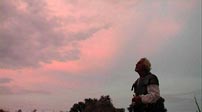
Fig. 1. Honor de cavalleria (2006) |
|
| |
The minimal narrative structure of contemporary slow cinema is predominantly achieved by a process of direct reduction, a sustained emptying out of deeply entrenched dramatic elements: the condensation of dense or sprawling literary texts in Honor de cavalleria and Tarr’s Werckmeister harmóniák (2000), adaptations of Cervantes’ Don Quixote and László Krasznahorkai’s The Melancholy of Resistance; the diminuition or prolongation of network narratives in Tsai’s Vive l’amour (1994), Tarr’s Sátántangó, Van Sant’s Elephant (2003) and Jia’s Still Life (2006) (fig. 2); or a fundamental reduction of the notion of linear storytelling to little more than the pleasures of a slow afternoon in Apichatpong’s Blissfully Yours (2002) or displaced wandering in Bartas’ Trys dienos (1991) (fig. 3), Van Sant’s Gerry and Costa’s Colossal Youth (2006). This reduction often risks boredom on the part of the spectator, dissolving traditional components of storytelling to either the most rudimentary basis of central conflict or a series of de-centred digressive events.
A Cinema of Walking
This form of de-dramatisation has its roots in European modernist cinema of the 1950s and 1960s, where emotional restraint began to suppress dramatic incident and the themes of alienation, isolation and boredom usurped the weight of familiar conflict. An aesthetic of slow exaggerates this tendency toward de-dramatisation, draining emotional distance and narrative obfuscation even further by extending the stretches of temps mort and subordinating non-events to extended duration within the shot. One direct factor of influence stems from the modernist introduction of a ‘cinema of walking’, the lineage of which can most likely be traced from Rossellini’s Viaggio in Italia (1953) to Antonioni’s L’Avventura (1960) by way of Varda’s La Pointe Courte (1954) and Resnais’s Hiroshima mon amour (1959). The time afforded to the mere act of walking signifies a rupture in the organisation of drama, and it assumes an even more prominent position in the contemporary cinema. Entire slabs of duration are given over to mobile tracking shots in pursuit of figures in José Luis Guerín’s En la ciudad de Sylvia (2007) (fig. 4), Van Sant’s Gerry (fig. 5), Elephant & Last Days (2005), and the late films of Béla Tarr.
In Tarr’s Sátántangó, many shots are either organised around the distant approach and subsequent retreat of characters, or devoted entirely to their sluggish yet determined motion: the Doctor’s quest for fruit brandy, the relocation of the troupe of villagers (fig. 6), or Futaki’s exodus at the end of the second day. Perhaps most significant is the sustained tracking shot that trails Irimiás and Petrina’s determined walk down the centre of a windswept road at the opening of the second chapter “Feltámadunk”. As detritus swirls around the two protagonists, Tarr’s camera repeatedly catches up and falls behind, maintaining a cadenced motion for almost two minutes (fig. 7). The shot’s narrative import (the tricksters’ journey to the courthouse) is afforded a duration that exceeds its signification, and as a result the take attains a feeling of supreme limitlessness. The trudging leads to no destination in sight, and there is no cycle to the shot’s containment of information; the beginning and end of the event chronicled, and therefore the cuts that organise it, could transpire at any point.
The pivotal nine-minute plan-sequence of Serra’s El Cant dels ocells (2008) might be thought to take this notion of a cinema of walking to its limit. The take begins with a pan that follows the Three Kings trudging across a barren landscape in medium-long shot, before resting in a static position to observe their gradual retreat along a slight diagonal axis into the distance. After five minutes they disappear over the horizon, only to re-emerge atop a subsequent ridge as mere inert specks dwarfed by the expanse of earth and sky. After seven minutes we are able to distinguish that the Magi have in fact begun to circle back toward us, and Serra cuts after the figures have regained half the ground between the horizon and the camera. In the initial stages of the shot, our attention is drawn to the unique corporeality of the subjects (their rotund bodies, awkward gait and listless movement), but the uncompromising length of the shot steadily begins to transform its very essence. The Magi’s gradual progress and physical exertion is eventually overwhelmed by extended temporality, and the concreteness of duration itself becomes an all-encompassing event. |
|
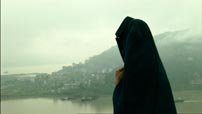
Fig. 2. Still Life (2006).
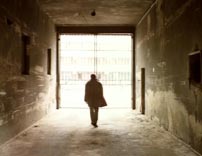
Fig. 3. Trys dienos (1991).
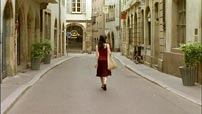
Fig. 4. The pursuit of Sylvia.

Fig. 5. Trudging across the salt flats in Gerry (2002).
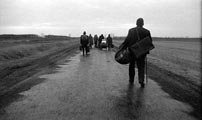
Fig. 6. The villagers relocate in Sátántangó (1994).
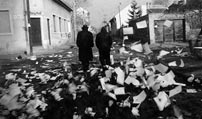
Fig. 7. Irimiás and Petrina’s determined walk. |
|
| |
In a manner reminiscent of Tarkovsky’s insistence that the ‘dominant, all-powerful factor of the film is rhythm, expressing the course of time within the frame’ (1987, p. 113), Serra elongates our sense of duration, liberating filmic time from the abstraction of intensified continuity or montage. Movement is slowed to a stage at which it becomes barely perceptible, and our intermittent awareness of the modulation of mise-en-scène marks the passage of time within the shot. Dramatic time is halted and reclaimed for us to engage with and reflect on our sensitivity to light and sound. Individual instances of this foregrounding of duration abound in contemporary slow cinema: the four-and-a-half minute take in Honor de cavalleria which offsets the motionlessness of Don and Sancho with the moon’s progressive arc across the sky (fig. 8); the opening and closing sequences of Stellet Licht (two six-minute time-lapse shots charting the break of day and onset of night) (fig. 9-10); or perhaps even the real-time teasing of Min’s erection in Blissfully Yours (fig. 11).
The Bazinian Real
The work of many filmmakers cited here strongly invites a rehabilitation of André Bazin’s criticism, in particular his formation of an ontological long take theory based on the artificial representation of objective reality. As evidenced by ”The Ontology of the Photographic Image,” Bazin’s writing is driven by an intense privileging of cinema’s capacity to photograph pure objectivity in time: “Now, for the first time, the image of things is likewise the image of their duration, change mummified as it were” (p. 15). He developed an affinity toward filmmakers who put their faith in the continuum of reality as opposed to the image, a preference that frequently dictated his choice of subjects for analysis: the neorealist aesthetic of Italian post-war cinema, the long take style of Jean Renoir, or the extreme deep-focus photography of Orson Welles and William Wyler. At times, Bazin’s criticism almost seems to pre-empt the movement toward contemporary slow cinema, most notably in his anxiety over the “limited commercial future” of La Terra Trema’s radically “austere ‘entertainment’” (review, p. 45), or his identification of a truly realist “cinema of ‘duration’” glimpsed in Umberto D (De Sica, p. 26). If it is possible to interpret his privileging of the durational real as a call for a particular mode of film practice, certain films by Alonso, Apichatpong, Kiarostami and Serra might be thought to be offer a belated elucidation.
In ”The Evolution of the Language of the Cinema,” Bazin argued that the purpose and effects of standard ‘analytic’ editing in mainstream filmmaking during the 1930s had become exclusively dramatic or psychological: as he believed that the subject or event being filmed exists objectively, “changes of point of view provided by the camera would add nothing”, only presenting reality “a little more forcefully” (p. 32). Dissatisfied with this synthetic abstraction of reality, he began to advocate an alternative method respectful of “the continuity of dramatic space and, of course, its duration”. Bazin identified in the cinema of Robert Flaherty and Erich von Stroheim a tendency in which “the image is evaluated not according to what it adds to reality but what it reveals of it” and a desire to not merely suggest time but instead show it, enabling the image fact to reveal itself in an apposite temporal field (p. 33). This distinction serves to lay bare the dialectical tension between intensified continuity and an aesthetic of slow: a deliberate retreat from forceful representation. Whereas intensified continuity generates an acceleration of pace through emphatic shot duration and free-ranging camera movement, the aesthetic of slow often refrains from disturbing the spatial and temporal unity inherent in pro-filmic reality. In contrast to the style of Flaherty, Renoir or De Sica, however, the Bazinian conception of the image fact is acutely magnified in the contemporary cinema, enlarged by extended duration.
The Dead
Lisandro Alonso’s understated style in particular is remarkably close to the Bazinian ideal of long take filmmaking, demonstratating a deep-seated belief that cinema allows us to examine the world clearly without interiorising it. His formal technique relies on little more than undramatic incident and the steady passage of time to carry each shot, analysing the dramatic field in time to represent a singular way of life without manifest embellishment. Perhaps in line with the notion that the average number of shots in a film diminishes as a function of their realism, Alonso’s films have thus far consisted of relatively few: 63 in La Libertad (2001), 77 in Los Muertos (2004), 43 in Fantasma (2006) and 68 in Liverpool (2008). Each of these films epitomise the notion of pure cinema delineated by Bazin in his review of Bicycle Thief (1948): “no more actors, no more story, no more sets”. The economy of storytelling (nothing more than an elemental quest), non-professional actors (inhabitants of the local area) and isolated rural locations are employed to create a “perfect aesthetic illusion of reality” (p. 60). |
|
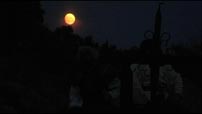
Fig. 8. The moon’s gradual arc marks the passage of time in Honor de cavalleria.


Fig. 9-10. Daybreak in Stellet Licht.
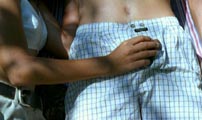
Fig. 11. Blissfully Yours. |
|
| |
The skeletal narrative of Los Muertos consists exclusively of the journey of an outsider from one inhibited or remote location to another, a central conceit revisited by Alonso in Liverpool. After being freed from prison, the sole protagonist Argentino Vargas embarks down a river (from Lavalle to the opening of the Yacare in north-eastern Argentina) to deliver a letter and visit his daughter. Vargas’ quest is related principally through a series of long takes allocated to nominal or mundane events: eating, packing, shaving, journeying, buying food and gifts, resting, smoking, collecting honeycomb. The linear itinerary is also punctuated by three deeply primordial acts that merge Alonso’s ontological approach to form with an investigation of culturally specific primitivism: the opening murder, impassive sex with a prostitute and the graphic slaughtering of a goat for sustenance (fig. 12). Each event is afforded an equivalent temporal representation, although it is important to note that shots are not dictated strictly by the absolute duration of events, as in, say, Akerman’s Jeanne Dielman, 23 Quai du Commerce, 1080 Bruxelles (1975) (fig. 13) or certain films by Tarr, Sokurov or Jia. An aesthetic of slow is rarely composed of a comprehensive sequence shot style, and Alonso occasionally cuts to a wider view, different angle or previously overlooked detail with a slight ellipsis. These cuts, however, do not serve to disrupt either the undramatic exposition or the spatial unity of events, and the film yields an ASL of 59.3 seconds.
A recurrent dynamic in Alonso’s editing technique is a sustained lingering after the event (or non-event) of the shot, a tendency ever-present throughout slow cinema. Many takes conclude with Vargas’ retreat to the rear of the frame or withdrawal from sight whilst Alonso’s camera lingers to contemplate the de-activated frame or pans to survey formerly negative space (fig. 14). In his analysis of Jeanne Dielman, Ben Singer defines this strategy as a “post-action lag”, referring to the manner in which Akerman lingers on objects for a few seconds before cutting to the next task of Jeanne’s routine (1989, p. 59). In an aesthetic of slow this device assumes a more pronounced durational quality, representing not so much the renewed visibility of editing but a means of calm attenuation. In one set-up that tracks his journey in the riverboat, we observe Vargas lay down his oars, swig water from a container, light a cigarette and rest whilst occasionally tending the paddles. Alonso concentrates on this action for three minutes before realigning the camera’s gaze, leaving Vargas behind and panning to the near-side bank before cutting away another minute later (fig. 15-17). This extended deferral of the imminence of editing opens a space for reflection on events, encouraging a contemplation of presence, gesture and material detail. In Theo Angelopoulos’ words, “the pauses, the dead time, give [the spectator] the chance not only to assess the film rationally, but also to create, or complete, the different meanings of a sequence” (Mitchell 1980, p. 33).
An aesthetic of slow uncompresses time, distends it, renewing the ability of the shot to represent a sense of the phenemological real. Herein lies the marked tension between fast and slow: whereas speed perpetually risks gratuitous haste, fragmentation and distraction, reduction intensifies the spectator’s gaze, awareness and response. An appropriate note on which to conclude might be one of the many imperative observations by Jean-Marie Straub in Pedro Costa’s Où gît votre sourire enfoui? (2001): “You have a sort of reduction, only it’s not a reduction, it’s a concentration and it actually says more. [...] You need time and patience. A sigh can become a novel.” |
|
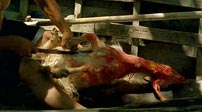
Fig. 12. Vargas guts his quarry in Los Muertos.
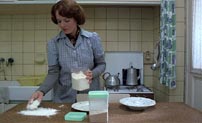
Fig. 13. Jeanne Dielman, 23 Quai du Commerce, 1080 Bruxelles (1975).
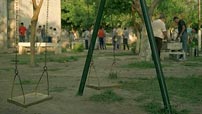
Fig. 14. The deserted frame in Los Muertos (2004).



Fig. 15-17. Alonso pans away from Vargas, lingers over landscape and delays the cut. |
|
 |
 |
 |
 |
 |
|
 |
 |
 |
| |
Facts
Ballard, Phil. “In search of truth: Béla Tarr interviewed”. Kinoeye 4.2 (2004).
Bazin, André. “Bicycle Thief”. What is Cinema? Volume II. Berkeley, London: University of California Press, 2005; p.47-60.
Bazin, André. “De Sica: Metteur en Scène”. What is Cinema? Volume II. Berkeley, London: University of California Press, 2005; p.61-78.
Bazin, André. “The Evolution of the Language of the Cinema”. What is Cinema? Volume I. Berkeley, London: University of California Press, 2005; p.23-40.
Bazin, André. “The Ontology of the Photographic Image”. What is Cinema? Volume I. Berkeley, London: University of California Press, 2005; p.9-16.
Bazin, André. “La Terra Trema”. What is Cinema? Volume II. Berkeley, London: University of California Press, 2005; p. 41-46.
Bazin, André. “William Wyler, or the Jansenist of Directing”. Bazin at Work: Major Essays and Reviews from the Forties and Fifties. New York: Routledge, 1996; p.1-22.
Bíró, Yvette. “The Fullness of Minimalism”. Rouge 9 (2006).
Bordwell, David. Figures Traced in Light: On Cinematic Staging. Berkeley, London: University of California Press, 2005.
Bordwell, David. “Intensified Continuity: Visual Style in Contemporary American Film”. Film Quarterly 55.3 (2002); p. 16-28.
Bordwell, David. “Unsteadicam Chronicles”. Observations on film art and Film Art (August 2007).
Bordwell, David. The Way Hollywood Tells It: Story and Style in Modern Movies. Berkeley, London: University of California Press, 2006.
Ciment, Michel. “The State of Cinema” (address delivered at the 46th San Francisco International Film Festival in 2003; archived here).
Gallagher, Tag. “Straub Anti-Straub”. Senses of Cinema 43 (2007).
Lopate, Phillip. “The Last Taboo: The Dumbing Down of American Movies”. Totally, Tenderly, Tragically. New York: Anchor Books, 1998; p.259-279.
Macaulay, Scott. “Sands of Time”. Filmmaker Magazine (Winter 2002).
Mitchell, Tony. “Animating Dead Space and Dead Time”. Sight & Sound 50.1 (1980); p. 29-33.
Quintín. “The Alonso Murder Case”. Cinema Scope 21 (2005); p. 38-40.
Ruiz, Raul. Poetics of Cinema. Paris: Editions Dis Voir, 1995.
Singer, Ben. “Jeanne Dielman: Cinematic Interrogation and ‘Amplification’”. Millennium Film Journal 22 (1989); p. 56-75.
Tarkovsky, Andrei. Sculpting in Time. Austin: University of Texas Press, 1987. |
|
|
|
|
 |
 |
 |
 |
16:9 - november 2008 - 6. årgang - nummer 29
Udgives med støtte fra Det Danske Filminstitut samt Kulturministeriets bevilling til almenkulturelle tidsskrifter.
ISSN: 1603-5194. Copyright © 2002-08. Alle rettigheder reserveret. |
11 |
|
|
 |
 |
|
|